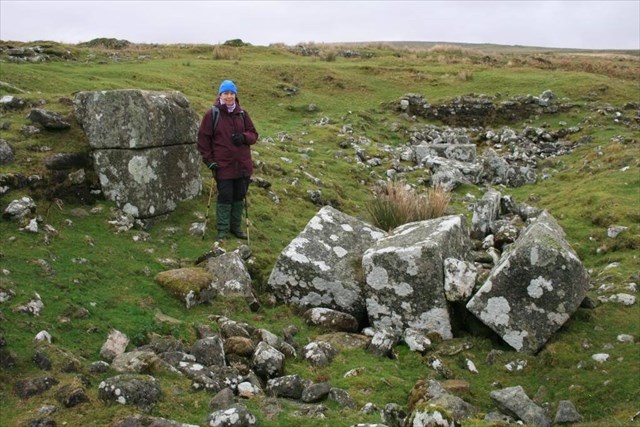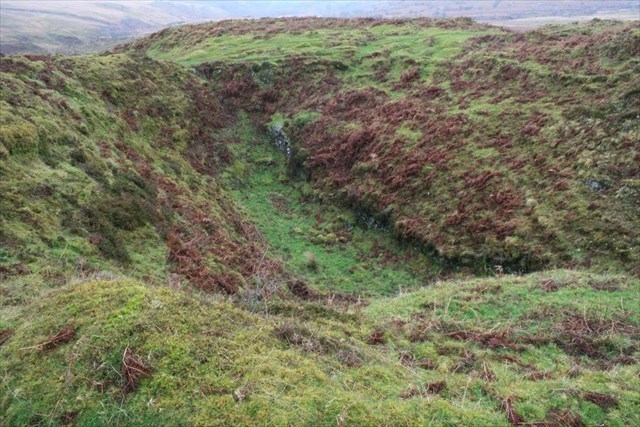The granite of Dartmoor was forced up from below through the rocks of the Devonian and Carboniferous periods about 290 million years ago. It did not break the surface and solidified while still underground. Granite consists mainly of quartz, mica and feldspar. It also contains some of the older native rocks both in solution and as particles and larger lumps. With this granite intrusion came mineral bearing fluids and gasses which eventually crystallised out over millions of years in cracks and fissures in the native rocks to form what we now know as lodes of mineral ore. The general trend was for tin ores to crystallise closest to the granite. Next came copper then lead/zinc and furthest from the granite, iron. Of course in practice the actual pattern is not that simple. Because the minerals were deposited in weak areas and fissures in the rocks, the long duration of the mineral deposition and the consequent faulting and erosion of the material above the granite, the final pattern is unpredictable. Tin ores are usually to be found in quartz veins in an impure form fused together with the constituents of the native granite. These veins are known as lodes and often include tourmaline, topaz, fluorite, apatite, wolframite, molybdenite, and arsenopyrite.
In the area of Eylesbarrow mine there were three main lodes of tin bearing ore, and several smaller ones. The ore concerned was cassiterite (Stannic oxide, SnO2). The lodes were running roughly ENE and some of them had been severely eroded and the cassiterite washed downstream. As it is much denser than the surrounding rocks some of it settled in depressions and river beds. The work of the early tinners was to recover this cassiterite, which they knew as ‘black tin’, from the sands and gravels in and near rivers. They smelted it in small blast furnaces using local charcoal to obtain metallic tin, ‘white tin’. The furnace sites are now known as blowing houses because they used water powered bellows to produce an air blast for their furnaces.
As the tinners worked upstream they worked out the stream deposits and reached the original lodes of tin ore and had to start working beneath ground level. At Eylesbarrow this first happened in about 1670. The mine was worked sporadically until 1852. The most prosperous period seems to have been during the 1820s.
The ore came from the ground in lumps which were too large for smelting and contained too much of the native rock. It had to be crushed to a fine powder and the rock element had to be removed. This process was known as dressing. At Eylesbarrow can be seen the remains of six ore dressing areas. Water wheels were used to power stamps for crushing the ore. The refining was done using concentrating tables, settling pits and buddles. These all involved different methods of using water to separate the dense cassiterite from the lighter rock particles. The black powder that remained was the same as the ‘black tin’ they used to recover from stream workings. The unwanted materials were known as tailings. Eylesbarrow mine was lucky in that its ore did not contain other metal impurities thus the need to separate them was avoided.
In one of the ore dressing areas are the remains of a reverberatory furnace. It is the only furnace of this type known on Dartmoor. In the furnace the ‘black tin’ was reduced to ‘white tin’. This was cast into ingots which were taken on horseback to Plympton for coinage.
On the hillside can be found well over twenty disused shafts. These were kept unwatered by adits and water powered pumps. Two adit mouths can still be seen and the leats which provide the water can still be traced on the ground. A system of flat rods was used to transmit the power from large water wheels to pumps in distant shafts. Several rows of roller supports for these flat rods can be followed over the hill.
Visit the site of the mine and:-
Go to the dressing floor at N 50° 29.499 W 003° 59.204. The large blocks of granite are the foundations/supports for the reverbatory furnace.
Photograph yourself or one of your party by the reverbatory furnace foundation.
While you’re there also have a look at the remains of the stone flue leading away from the furnace site to where the chimney once stood.
Count how many of the stone pillars that once supported a roof are still standing at the end of the ore dressing area.

Go to the large wheel pit at N 50° 29.712 W 003° 58.905. This is the second largest of the wheel pits on the site. You will find there is a row of flat rod roller supports which leaves the pit area on a bearing of 060°.
Photograph one of the supports with your GPS or similar sized object
Examine the roller support and estimate of the diameter of the roller axle.


Go to the huge wheel pit at N 50° 29.809 W 003° 59.111. This was the largest wheel pit on the mine. It had been built by widening a disused shaft. It held a water wheel over 50 feet in diameter most of which was below ground level. The large crank needed to convert the rotary movement of the wheel into the reciprocating movement of the flat rods and pumps was also contained in this pit.

Go a few metres further to the adit opening at N 50° 29.819 W 003° 59.104.
Photograph yourself or a member of your party close to the adit mouth.
Estimate the height of the opening from floor to lintel and its width between uprights.

Before recording this cache as a find please message us with your answers to the following questions by clicking on "Message this owner" at the top of the page:-
a. How many pillars were there?
b. What was the diameter of the roller axle?
c. What are the dimensions of the adit mouth?
d. What chemical was being refined in the dressing area.?
e. What would you expect to be the main constituents of the tailings from the dressing areas?
When recording your find please post photographs of:-
a. yourself or one of your party by the reverbatory furnace foundation.
b. one of the flat rod roller supports with your GPS or similar sized object.
c. yourself or a member of your party close to the adit mouth.